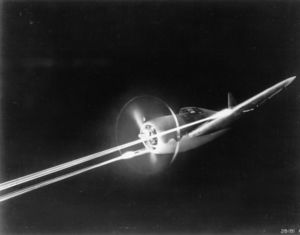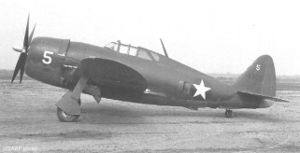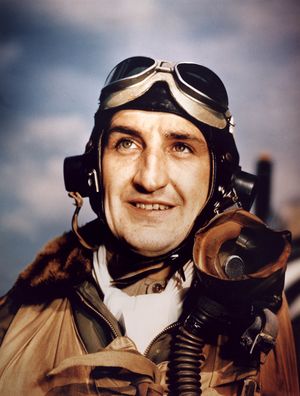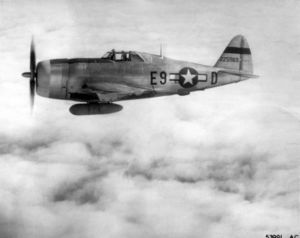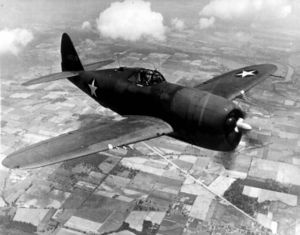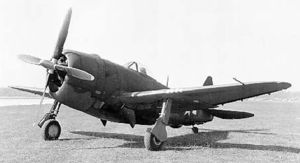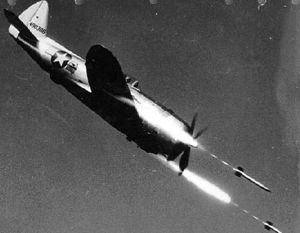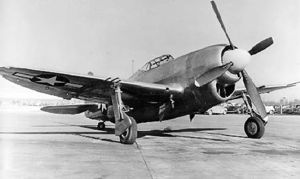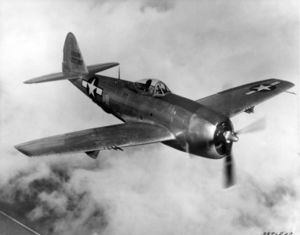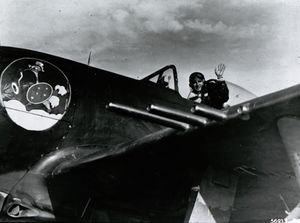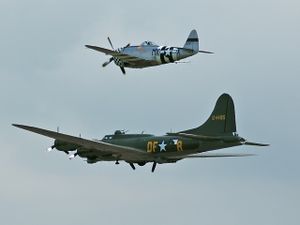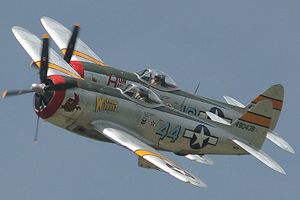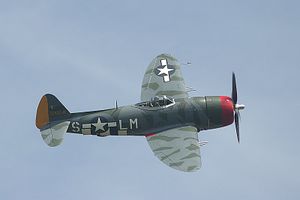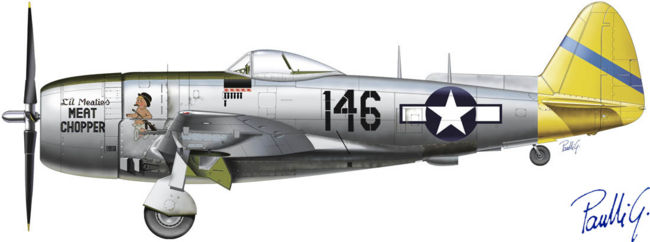PlaneSpottingWorld welcomes all new members! Please gives your ideas at the Terminal.
P-47 Thunderbolt
| P-47 Thunderbolt | |
|---|---|
| USAAF P-47D-25-RE | |
| Type | Fighter-bomber |
| Manufacturer | Republic Aviation Company |
| Designed by | Alexander de Seversky Alexander Kartveli |
| Maiden flight | 6 May 1941 |
| Introduced | 1942 |
| Retired | 1955, US ANG |
| Primary user | United States Army Air Force |
| Number built | 15,686 |
| Unit cost | US$83,000 in 1945[1] |
| Variants | Republic XP-72 |
The American Republic P-47 Thunderbolt, also known as the "Jug," was the largest single-engined fighter of its day. It was one of the main United States Army Air Force (USAAF) fighters of the Second World War. The P-47 was effective in air combat but proved especially adept in the ground attack role. Its modern-day equivalent, the A-10 Thunderbolt II takes its name from the P-47. The Thunderbolt also served with a number of other Allied air forces.
Contents
Development
The P-47 Thunderbolt was the product of two Georgian immigrants, Alexander de Seversky and Alexander Kartveli, who had left their homeland to escape the Bolsheviks.
P-43 Lancer / XP-47B
In 1939, the Republic Aviation Company designed an AP-4 demonstrator powered by a Pratt & Whitney R-1830 radial engine with a belly-mounted turbocharger. While the resulting P-43 Lancer was in limited production, Republic had been working on an improved P-44 Rocket with a more powerful engine, as well as on a fighter designated the AP-10. The latter was a a lightweight aircraft powered by the Allison V-1710 liquid-cooled V-12 engine and armed with a pair of 0.50 caliber (12.7 mm) machine guns. The United States Army Air Corps (USAAC) backed the project and gave it the designation XP-47.
As the war in Europe escalated in the spring of 1940, Republic and the USAAC concluded that the XP-44 and the XP-47 were inferior to the German fighters. Republic unsuccessfully attempted to improve the design, proposing the XP-47A. Alexander Kartveli subsequently came up an all-new and much larger fighter which was offered to the USAAC in June 1940. The Air Corps ordered a prototype in September, to be designated the XP-47B. The XP-47A, which had almost nothing in common with the new design, was abandoned.
The XP-47B was all-metal construction (except for fabric-covered tail control surfaces) with elliptical wings. The cockpit was roomy and the pilot's seat was comfortable, "like a lounge chair" as one pilot would later put it. The pilot was provided with every convenience, including cabin air conditioning. The canopy doors hinged upward. Main and auxiliary self-sealing fuel tanks were placed under the cockpit, giving a total fuel capacity of 305 US gallons (1,155 L).
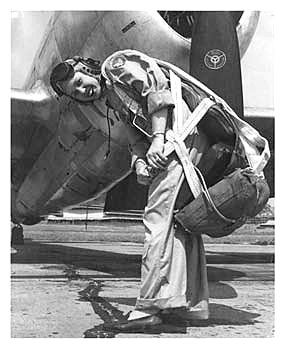
Power came from a Pratt & Whitney R-2800 Double Wasp two-row 18-cylinder radial engine producing 2,000 hp (1,500 kW) and turning a four-bladed Curtiss Electric constant-speed propeller 146 inches (3.7 m) in diameter. The loss of the AP-4 prototype to an engine fire ended Kartveli's experiments with tight-fitting cowlings, so the engine was placed in a broad cowling that opened at the front in a "horse collar"-shaped ellipse. The cowling admitted air for the engine, left and right oil coolers, and the turbosupercharger intercooler system. The engine exhaust gases were routed into a pair of wastegate-equipped pipes that ran along each side of the cockpit to drive the turbosupercharger turbine at the bottom of the fuselage about halfway between cockpit and tail. At full power, the pipes glowed red at their forward ends and the turbine spun at 60,000 revolutions per minute. The complicated turbosupercharger system with its ductwork gave the XP-47B a deep fuselage, and the wings had to be mounted in a relatively high position. This was problematic since long landing gear were needed to provide ground clearance for the propeller. To reduce the size and weight of the long landing gear, it was fitted with an ingenious mechanism by which it telescoped out nine inches (230 millimeters) when extended.
XP-47B was a very large aircraft for its time with an empty weight of 9,900 pounds (4,490 kg), or 65 percent more than the YP-43. Kartveli is said to have remarked, "It will be a dinosaur, but it will be a dinosaur with good proportions."[2] The armament consisted of eight 0.50 caliber machine guns, four in each wing. The guns were staggered to allow feeding from side-by-side ammunition boxes, each with a 350-round capacity. Although the British already possessed eight-gun fighters in the form of the Hurricane and the Spitfire, these used the smaller .303 inch (7.7 mm) guns.
The XP-47B first flew on 6 May 1941 with Lowry P. Brabham at the controls. Although there were minor problems, such as some cockpit smoke that turned out to be due to an oil drip, the aircraft proved impressive in its first trials. It was eventually lost in an accident in August 1942.
P-47B / P-47C / XP-47E / XP-47F
The XP-47B gave the United States Army Air Forces (as the Air Corps became known in June 1941) cause for both optimism and apprehension. While possessing good performance and firepower, the XP-47B had its share of teething problems.
Its sheer size and power made for challenging takeoffs which required long runways. There were problems with canopy jams, with the guns, with the fuel system, and with the engine installation. At high altitudes, the ignition system arced, and the loads on the control surfaces became unacceptable, causing the ailerons to lock up. The fabric-covered control surfaces also tended to rupture at high altitudes due to the air trapped in them.
Republic addressed the problems, coming up with a sliding canopy that could be jettisoned in an emergency, a pressurized ignition system, and new all-metal control surfaces. While the engineers worked frantically to get their "dinosaur" to fly right, the USAAF ordered 171 P-47Bs. An engineering prototype P-47B was delivered in December 1941, with a production prototype following in March 1942, and the first production model provided in May. Republic continued to improve the design as P-47Bs were produced, and although all P-47Bs had the sliding canopy and the new General Electric turbosupercharger regulator for the R-2800-21 engine, features such as all-metal control surfaces were not standard at first. A modification unique to the P-47B was the radio mast behind the cockpit that was slanted forward to maintain the originally designed antenna wire length in spite of the new sliding canopy.
The P-47B not only led to the P-47C but to a few other "one off" variants. A single reconnaissance variant designated RP-47B was built. In September 1942, the 171st and last P-47B (41-6065) was also used as a test platform under the designation XP-47E to evaluate the R-2800-59 engine, a pressurized cockpit with a hinged canopy and, eventually, a new Hamilton Standard propeller. The plans for production were cancelled after increased emphasis on low-level operations over Europe.[2][3] Another P-47B was later fitted with a new laminar flow wing in search of higher performance and redesignated XP-47F.
Operational history
Initial deliveries of the Thunderbolt to the USAAF were to the 56th Fighter Group, which was also on Long Island. The 56th served as an operational evaluation unit for the new fighter. Teething problems continued. A Republic test pilot was killed in an early production P-47B when it went out of control in a dive, and crashes occurred due to failure of the tail assembly. The introduction of all-metal control surfaces and other changes corrected these problems. In spite of the problems, the USAAF was interested enough to order an additional 602 examples of the refined P-47C, with the first of the variant delivered in September 1942.
Beginning in January 1943, Thunderbolt fighters were sent to the joint Airforce and Civilian Millville Airport in Millville, NJ in order to train civilian and military pilots.
P-47C
Essentially similar to the P-47B, the initial P-47Cs featured strengthened all-metal control surfaces, an upgraded GE turbosupercharger regulator and a short vertical radio mast. After the initial manufacture of a block of 57 P-47Cs, production moved to the P-47C-1, which had an eight inch (200 mm) fuselage extension forward of the cockpit at the firewall to correct center of gravity problems, ease engine maintenance and allow installation of a new engine mount. There were a number of other changes, such as revised exhausts for the oil coolers, and fixes to brakes, undercarriage and electrical system as well as a redesigned rudder and elevator balance. The 55 P-47C-1s were followed by 128 P-47C-2s which introduced a centerline hardpoint with under-fuselage shackles for either a 500 pound (227 kg) bomb or a 200 US gallon (758 L, 166.5 imp. gal) fuel tank. The main production P-47C subvariant was the P-47C-5 which introduced a new whip antenna and the R-2800-59 engine with water-methanol injection with a war emergency power rating of 2,300 horsepower (1,700 kW). The P-47C was able to fly extended, long-range missions beginning in July 1943.[4]
P-47 enters combat
P-47Cs were sent to England for combat operations in late 1942. The 56th FG was sent overseas to join the Eighth Air Force, whose 4th and 78th Fighter Groups were also equipped with the Thunderbolts. The 4th Fighter Group was built around a core of experienced American pilots, volunteers who had served with the British Royal Air Force (RAF) during 1941-42 in the Eagle Squadrons. Commenting on the P-47s size, British pilots joked that a Thunderbolt pilot could defend himself from a Luftwaffe fighter by running around and hiding in the fuselage.
The first P-47 combat mission took place 10 March 1943 when the 4th FG took their aircraft on a fighter sweep over France. The mission was a failure due to radio malfunctions. All P-47s were refitted with British radios, and missions resumed 8 April. The first P-47 air combat took place 15 April with Major Don Blakeslee of the 4th FG scoring the Thunderbolt's first air victory. On 17 August, the P-47s performed their first escort mission, protecting a B-17 force on the first leg of a raid on Schweinfurt, Germany.
By the summer of 1943, the Jug was also in service with the 12th Air Force in Italy, and it was fighting against the Japanese in the Pacific with the 348th Fighter Group flying escort missions out of Brisbane, Australia.
P-47D / P-47G / XP-47K / XP-47L
Refinements of the Thunderbolt continued, leading to the definitive P-47D, of which 12,602 examples were built. The "D" model actually consisted of a series of evolving production blocks, the last of which were visibly different from the first.
The first P-47Ds were actually the same as P-47Cs. Republic could not produce Thunderbolts fast enough at its Farmingdale plant on Long Island, so a new plant was built at Evansville, Indiana. The Evansville plant built a total of 110 P-47Ds, which were completely identical to P-47C-2s. Farmingdale aircraft were identified by the "-RE" suffix after the block number, while Evansville aircraft were given the "-RA" suffix.
The P-47D-1 through P-47D-6, the P-47D-10, and the P-47D-11 successively incorporated changes such as the addition of more engine cooling flaps around the back of the cowl to reduce the engine overheating problems that had been seen in the field. Engines and engine subsystems saw refinement, as did the fuel, oil and hydraulic systems. Additional armor protection was also added for the pilot.
The P-47D-15 was produced in response to requests by combat units for increased range. The internal fuel capacity was increased to 375 US gallons (1,421 L) and the bomb racks under the wings were made "wet" (equipped with fuel plumbing) to allow a drop tank to be carried under each wing, in addition to the belly tank. A variety of different drop tanks were fitted to the Thunderbolt during its career — following the early conformal 200 US gallon (758 L) ferry tank and the lozenge-shaped flat 200 US gallon belly tank, teardrop-shaped 75 US gallon (284 L) and 150 US gallon (568 L) metal underwing drop tanks were developed. The P-47 could also carry British-designed 108 US gallon (409 L) and 200 US gallon tanks made of plastic-impregnated paper. Though they could not store fuel for an extended period of time, they worked quite well for the time it took to fly a single mission. These tanks were cheaper, lighter and were useless to the enemy if found after being dropped — not only did they break apart, but they did not provide the enemy with any reusable materials that could be scavenged for their own war effort. With the increased fuel capacity, the P-47 was now able to perform escort missions deep into enemy territory.
The P-47D-16, P-47D-20, P-47D-22, and P-47D-23 were similar to the P-47D-15 with minor improvements in fuel system, engine subsystems, a jettisonable canopy, and bulletproof windshield. The Curtiss propeller was replaced by new and bigger propellers, with the Long Island plant moving to a Hamilton Standard propeller with a diameter of 157.875 inches (4.01 m), and the Evansville plant switching to a new Curtiss propeller with a diameter of 156 inches (3.96 m). With the bigger propellers, Thunderbolt pilots had to learn to be careful on takeoffs to keep the tail down until they obtained adequate ground clearance. Failure to do so damaged both the propeller and the runway.
Even with two Republic plants rolling out the P-47, the USAAF still was not getting as many Thunderbolts as they wanted, consequently, an arrangement was made with Curtiss to build the aircraft under license in a plant in Buffalo, New York. Most of the Curtiss Thunderbolts were intended for use in advanced flight training. The Curtiss aircraft were all designated P-47G, and a "-CU" suffix was used to distinguish them from other production. The first P-47G was completely identical to the P-47C, the P-47G-1 was identical to the P-47C-1, while the following P-47G-5, P-47G-10, and P-47G-15 subvariants were comparable to the P-47D-1, P-47D-5, and P-47D-10 respectively. Two P-47G-15s were built with the cockpit extended forward to just before the leading edge of the wing to provide twin tandem seating, designated TP-47G. The second crew position was accommodated by substituting a much smaller main fuel tank. The "Doublebolt" did not go into production but similar modifications were made in the field to older P-47s, which were then used as squadron "hacks" (miscellaneous utility aircraft). Curtiss built a total of 354 P-47Gs.
Bubbletop P-47s
All the P-47s to this point had a "razorback" canopy configuration with a tall fuselage spine behind the pilot which resulted in poor visibility to the rear. The British also had this problem with their fighter aircraft, and had devised the bulged "Malcolm hood" canopy for the Spitfire as an initial solution. This was fitted in the field to many North American P-51 Mustangs, and to a handful of P-47Ds. However, the British then came up with a much better solution, devising an all-round vision "bubble" canopy for the Hawker Typhoon. USAAF officials liked the bubble canopy, and quickly adapted it to American fighters, including the P-51 and the Thunderbolt. The first P-47 with a bubble canopy was a modified P-47D-5 completed in the summer of 1943 and redesignated XP-47K. Another older P-47D was modified to provide an internal fuel capacity of 370 US gallons (1,402 L) and given the designation XP-47L. The bubble canopy and increased fuel capacity were then rolled into production together, resulting in the P-47D-25.
It was followed by similar bubble-top variants, including the P-47D-26, P-47D-27, P-47D-28, and P-47D-30. Improvements added in this series included engine refinements, more internal fuel capacity, and the addition of dive recovery flaps. Cutting down the rear fuselage to accommodate the bubble canopy produced yaw instability, and the P-47D-40 introduced a dorsal fin extension in the form of a narrow triangle running from the vertical tailplane to the radio aerial. The fin fillet was retrofitted in the field to earlier P-47D bubble-top variants. The P-47D-40 also featured provisions for ten "zero length" stub launchers for 5 inch (127 mm) High Velocity Aerial Rockets (HVARs), as well as the new K-14 computing gunsight. This was a license-built copy of the British Ferranti GGS Mark IID computing gyroscopic sight which allowed the pilot to dial in target wingspan and range, and would then move the gunsight reticle to compensate for the required deflection.
P-47 as a fighter-bomber
By 1944, the Thunderbolt was in combat with the USAAF in all its operational theaters, except the Battle of the Aleutian Islands. With increases in fuel capacity as the type was refined, the range of escort missions over Europe steadily increased until the P-47 was able to accompany bombers in raids all the way into Germany. On the way back from the raids, pilots shot up ground targets of opportunity which led to the realization that the P-47 could perform a dual-function on escort missions as a fighter-bomber. Even with its complicated turbosupercharger system it could absorb a lot of damage, and its eight machine guns could inflict heavy damage on lightly armored targets. The P-47 gradually became the USAAF's best fighter-bomber, carrying the 500 pound (227 kg) bombs, the triple-tube M-8 4.5 inch (115 mm) rocket launchers, and eventually HVARs. The P-47 destroyed thousands of tanks, locomotives, and parked aircraft, and tens of thousands of trucks and other vehicles [citation needed].
Although the P-51 Mustang replaced the P-47 in the escort role, the Thunderbolt still ended the war with 3,752 kills claimed in over 746,000 sorties of all types, at the cost of 3,499 P-47s in combat.[5] In Europe, the Thunderbolt flew more sorties (423,435) than P-51s, P-38s, and P-40s combined.
The 56th FG was the only 8th Air Force unit still flying the P-47, by preference, instead of the P-51 by the end of the war. The unit claimed 647 air victories and 311 ground kills, at the cost of 128 aircraft.[6] Lieutenant Colonel Francis S. "Gabby" Gabreski scored 31 victories,[7] including three ground kills, Captain Bob Johnson scored 27 (with one unconfirmed probable kill leading to some giving his tally as 28),[8] and 56th FG Commanding Officer Colonel Hubert Zemke scored 17.75 kills.[9]
In the Pacific, Col Neel Kearby of the 5th Air Force destroyed 22 Japanese planes and was awarded the Medal of Honor for an action in which he downed six enemy fighters on a single mission. He was shot down and killed over Biak in March 1944.[10]
P-47 in non-US service
P-47s were operated by several Allied air arms during World War II. The RAF received 240 razorback P-47Ds which they designated "Thunderbolt Mark I," and 590 bubbletop P-47Ds, designated "Thunderbolt Mark II"s. Except for a few evaluation aircraft, these were operated by the RAF from India for ground attack operations, known as "cab rank" sorties, against the Japanese in Burma. They were armed with 500 pound (227 kg) bombs or, in some cases, the British "60 pounder" (27 kg) RP-3 rocket projectiles. The Thunderbolts remained in RAF service until October 1946.
The Brazilian Expeditionary Force received 88 P-47Ds, flying them in combat during the Italian campaign. In 1945, the Mexican Escuadron Aereo de Pelea 201| (201st Fighter Squadron) operated P-47Ds as part of the US Fifth Air Force in the Philippines. In 791 sorties against Japanese forces, the 201st lost no pilots or planes to enemy action.[11] The Free French Air Force received 446 P-47Ds in the last year of the war in Europe, and these aircraft would see action in the 1950s during the Algerian War of Independence.
The Soviet Union also received 203 P-47Ds. The fighters were assigned to high-altitude air defense over major cities in rear areas. Unlike their Western counterparts, the Soviet Air Force made no notable use of the P-47 as a ground attack aircraft, depending instead on the P-39, P-63, and their own widely-produced Ilyushin Il-2.
XP-47H / XP-47J / P-47M / P-47N
Republic made several attempts to further improve the P-47D:
Two XP-47Hs were built. They were major reworkings of existing razorback P-47Ds to accommodate a Chrysler XI-2220-11 water-cooled inline 16-cylinder inverted vee engine. However, such large inline engines did not prove to be especially effective.
The XP-47J began as a November 1942 request to Republic for a high-performance version of the Thunderbolt using a lighter airframe and an uprated engine with water injection and fan cooling. Kartveli designed an aircraft fitted with a tight-cowled Pratt & Whitney R-2800-57(C) with a war emergency rating of 2,800 horsepower (2,090 kW), reduced armament of six 0.50 inch (12.7 mm) machine guns, a new and lighter wing, and many other changes. The first and only XP-47J was first flown in late November 1943. When fitted with a GE CH-5 turbosupercharger, the XP-47J achieved a top speed of 440 knots (505 mph, 813 km/h) in level flight in August 1944, making it one of the fastest piston engine fighters ever built. However, by that time Republic had moved on to a new concept, the XP-72.
The P-47M was a more conservative attempt to come up with a higher-performance version of the Thunderbolt. Three P-47Ds were modified into prototype YP-47Ms by fitting the R-2800-57(C) engine and the GE CH-5 turbo-supercharger. The YP-47M had a top speed of 410 knots (473 mph, 761 km/h) and it was put into limited production with 130 built. However, the type suffered serious teething problems in the field due to the highly-tuned engine, and by the time the bugs were worked out, the war in Europe was over.
The P-47N was the last Thunderbolt variant to be produced. It was designed as an escort fighter for the B-29 Superfortress bombers flying raids on the Japanese home islands. Increased internal fuel capacity and drop tanks had done much to extend the Thunderbolt's range during its evolution, and the only other way to expand the fuel capacity was to put fuel tanks into the wings. Thus, a new wing was designed with two 50 US gallon (190 L) fuel tanks. The second YP-47M with this wing flew in September 1944. The redesign proved successful in extending range to about 2,000 miles (3,200 km), and the squared-off wingtips improved the roll rate. The P-47N entered mass production with the uprated R-2800-77(C) engine, with a total of 1,816 built. The very last Thunderbolt to be built, a P-47N-25, rolled off the production line in October 1945. Thousands more had been on order, but production was essentially cut off with the end of the war in August. At the end of production, cost of a Thunderbolt was $83,000 in 1945 US dollars.
Postwar service
The USAF Strategic Air Command had P-47 Thunderbolts in service from 1946 through 1947.
The P-47 served with the Army Air Forces (United States Air Force after 1947) until 1949, and with the Air National Guard until 1953, receiving the designation F-47 in 1948. P-47s also served as spotters for rescue aircraft such as the OA-10 Catalina and Boeing B-17H.
The type was provided to many Latin American air forces some of which operated it into the 1960s. Small numbers of P-47s were also provided to China, Iran, Turkey, and Yugoslavia.
A total of 15,686 Thunderbolts of all types were built, making it one of the most heavily produced fighter aircraft in history. A number of P-47s have survived to the present day, and a few are still flying.
Flying the Thunderbolt
All P-47s had an inherent ground handling challenge exacerbated by torque of the large propeller and the large nose that was difficult to see over during taxiing. Ground crewmen sometimes sat on the wing and used hand signals to provide directions to the pilot. The heavy weight resulted in a long takeoff run and, once in the air, the P-47 was not particularly maneuverable, though it became more agile, in comparison to most other fighters, at high altitudes. It did possess a good roll rate and climb/dive performance. Its success in combat depended on utilizing energy-conserving "dive-and-zoom" tactics. One Thunderbolt pilot compared it to flying a bathtub around the sky. On the positive side, the P-47 was rugged and well-armed. It could sustain a large amount of damage and still be able to get its pilot back to base. Quentin C. Aanenson documented his experiences flying the Thunderbolt on D-Day and subsequently in the European Theater in his video documentary "A Fighter Pilot's Story," aired on PBS in 1994.
The Thunderbolt was also one of the fastest-diving aircraft of the war — it could reach speeds of 480 knots (550 mph, 885 km/h). Major Robert S. "Bob" Johnson described the experience of diving the big fighter by writing, "the Thunderbolt howled and ran for the earth".[12] Some P-47 pilots claimed to have broken the sound barrier, but later research revealed that due to the pressure buildup inside the Pitot tube at high speeds, airspeed readings became unpredictably exaggerated.
Operators
- Template:BOL
- Template:BRA
- Template:CHI
- Template:ROC
- Template:COL
- Template:CUB
- Template:DOM
- Template:ECU
- Template:ESA
- Template:FRA
 Germany: Luftwaffe (captured)
Germany: Luftwaffe (captured)- Template:HON
- Template:IRN
- Template:ITA
- Template:MEX
- Template:NIC
- Template:PER
- Template:POR
- Template:USSR
- Template:TUR
- Template:UK
- Template:USA
- Template:VEN
- Template:YUG
Survivors

- P-47D, serial no. 42-23278 National Museum of the United States Air Force, Dayton, OH
- P-47D-RE, "razorback," serial no. 42-22331 (wreckage in storage) Carolinas Aviation Museum, Charlotte, NC
- P-47D-30-RE, serial no. 44-20371, Musée de l'Air et de l'Espace, Le Bourget, France
- P-47D-30-RA, serial no. 44-32691, National Air and Space Museum (Smithsonian), Washington, DC
- P-47D-40-RA, "Tarheel Hal," serial no. 44-90368, Lone Star Flight Museum
- P-47D, "Norma," serial no. 45-4945, New England Air Museum, Windsor Locks, CT
- P-47D, serial no. 45-49181/N444SU,painted as Francis "Gabby" Gabreski's "HV-A," Kalamazoo Air Zoo, Kalamazoo, MI
- P-47D, serial no. 45-49167,National Museum of the United States Air Force, Dayton, OH
- P-47D, serial no. N7159Z (under restoration) Flying Heritage Collection, Arlington, WA
- P-47D, "Big Stud," serial no. N14519, Museum of Flight, Seattle, WA
- P-47D, "Big Chief," serial no. N47RP, Palm Springs Air Museum Palm Springs, CA
- P-47D, "Hun Hunter IV" and P-47D, "Wicked Wabbit," Tennessee Air Museum, Gatlinburg, TN
- P-47D, "Hairless Joe" Serial #: 44-90471, owned by Henry J. “Butch” Schroeder
- P-47D, serial no: 44-90447, flying example at original factory at Republic Airport, at the American Airpower Museum in Farmingdale, NY.
- P-47M, serial no.G-THUN "No Guts No Glory", The Fighter Collection, Duxford UK
- P-47N, serial no. N47TB Commemorative Air Force (CAF), Midland, TX
- P-47N, serial no. 44-89425, Peterson Air & Space Museum Peterson AFB, Colorado
- P-47N, serial no. 44-89320, USAF Armament Museum, Eglin AFB, Florida
- P-47D-25-RE s/n 42-26760,Brazilian Air Force Propertie, currently leased to Museu Asas de um Sonho, São Carlos - Brasil
Specifications (P-47D Thunderbolt)
General characteristics
- Crew: One
- Length: 36 ft 1 in (11.00 m)
- Wingspan: 40 ft 9 in (12.44 m)
- Height: 14 ft 7 in (4.45 m)
- Wing area: 300 ft² (27.87 m²)
- Empty weight: 10,000 lb (4,535 kg)
- Loaded weight: lb (kg)
- Max takeoff weight: 17,500 lb (7,935 kg)
- Powerplant: 1× Pratt & Whitney R-2800-59 twin-row radial engine, 2,535 hp (1,890 kW)
Performance
- Maximum speed: 426 mph at 30,000 ft (685 km/h at 9,145 m)
- Range: 800 miles combat, 1,800 mi ferry (1,290 km / 2,900 km)
- Service ceiling: 43,000 ft (13,100 m)
- Rate of climb: 3,120 ft/min (15.9 m/s)
Armament
- 8x 0.5 in (12.7 mm) M2 Browning machine guns
- Up to 2,000 lb (907 kg) of bombs
- 10x 5 in (127 mm) unguided rockets
P-47 Thunderbolt in popular culture
Czech composer Bohuslav Martinů paid a tribute to the airplane with his scherzo for orchestra Thunderbolt P-47. It was premiered 19 December 1945 in Washington, D.C..
Steve Earle's song "Johnny Come Lately" is about an American P-47 pilot in World War II; it contains a verse "My P-47 is a pretty good ship/ She took a round comin' cross the channel last trip."
References
- ↑ Knaack, Marcelle Size. Encyclopedia of US Air Force Aircraft and Missile Systems: Volume 1 Post-World War II Fighters 1945-1973. Washington, DC: Office of Air Force History, 1978. ISBN 0-912799-59-5.
- ↑ P-47 Thunderbolt. Top Fighters.com (2006). Retrieved on 12 July, 2006.
- ↑ Green 1961, p.178.
- ↑ Green 1961, p.173.
- ↑ Republic P-47D Thunderbolt. Museum of Flight (2004). Retrieved on 12 July, 2006.
- ↑ 8th Air Force 56th FG. U.S. Army Air Forces in World War II (June 18 2004). Retrieved on 14 July, 2006.
- ↑ Francis S. "Gabby" Gabreski. USAF Air University. Maxwell-Gunter AFB (17 April 2006). Retrieved on 14 July, 2006.
- ↑ Rose, Scott (11 June 2006). Robert S. Johnson. Warbirds Resource Group. Retrieved on 14 July, 2006.
- ↑ Col. Hubert 'Hub' Zemke. Acepilots.com (29 July 2003). Retrieved on 14 July, 2006. Zemke flew a P-38 for three of his kills
- ↑ Colonel Neel Earnest Kearby. Air Force History. Air Force Historical Studies Office (20 January 2004). Retrieved on 14 July, 2006.
- ↑ Velasco, E. Alfonso, Jr. (2006 9 January). Aztec Eagle - P-47D of the Mexican Expeditionary Air Force. IPMS Stockholm. Retrieved on 14 July, 2006.
- ↑ P-47 Thunderbolt. [1] Access date: 14 July 2006.
- Cain, Charles W. and Gerram, Mike.Fighters of World War II. Profile Publications, 1979.
- Davis, Larry.P-47 Thunderbolt in Action, Squadron/Signal Publications (#67). Carrollton, Texas: Squadron/Signal Publications, 1984. ISBN 0-89747-161-X.
- Donald, David (ed.) American Warplanes of the Second World War.London: Airtime Publications, 1995. ISBN 1-84013-392-9.
- Green, William. Fighters Vol. 2 (Warplanes of the Second World War). New York: Doubleday and Company, Inc., 1961.
- Mondey, David. American Aircraft of World War II.Edison, New Jersey: Book Sales, 1996. ISBN 0-7858-1361-6.
- Mondey, David. The Concise Guide to American Aircraft of World War II. London: Chartwell Books, Inc., 1994. ISBN 0-7858-0147-2.
This page is based on "The Republic P-47 Thunderbolt", version 1.1, by Greg Goebel. The original version (placed in the public domain) can be accessed at: [3]
External links
Related content
Related development
Comparable aircraft
- Focke-Wulf Fw 190
- Grumman F6F Hellcat
- Hawker Tempest
- Polikarpov I-185
- Vought F4U Corsair
- Kawasaki Ki-100
Designation sequence
P-44 -
XP-45 -
XP-46 -
P-47 -
XP-48 -
XP-49 -
XP-50
Related lists
List of military aircraft of the United States - List of fighter aircraft
Lists relating to aviation | |
|---|---|
| General | Timeline of aviation · Aircraft · Aircraft manufacturers · Aircraft engines · Aircraft engine manufacturers · Airports · Airlines |
| Military | Air forces · Aircraft weapons · Missiles · Unmanned aerial vehicles (UAVs) · Experimental aircraft |
| Notable incidents and accidents | Military aviation · Airliners · General aviation · Famous aviation-related deaths |
| Records | Flight airspeed record · Flight distance record · Flight altitude record · Flight endurance record · Most produced aircraft |
cs:P-47 Thunderbolt de:Republic P-47 es:P-47 Thunderbolt fa:پ-۴۷ تاندربولت fr:Republic P-47 Thunderbolt gl:P-47 Thunderbolt he:ריפליק P-47 it:Republic P-47 Thunderbolt ms:Republic P-47 nl:P-47 Thunderbolt ja:P-47 (航空機) no:Republic P-47 Thunderbolt pl:Republic P-47 Thunderbolt pt:Republic P-47 Thunderbolt sr:П-47 Тандерболт fi:P-47 Thunderbolt sv:Republic P-47 Thunderbolt tr:Republic P-47
